SALTWATER CHRONICLES FLY FISHING ADVENTURES IN SALTWATER (part 12)
| Sysadmin Note |
|---|
| Part 11 can be found here |
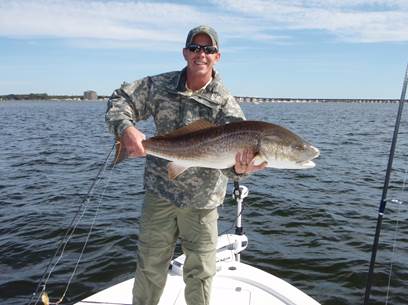
Redfish
Redfish [Sciaenops ocellatus] are a member of the Drum family and are close cousins to black drum and Atlantic croakers. They are found all along the coastal waters of Florida and depending on the location you may hear redfish referred to as red drum, reds, bull reds, spot tail bass, puppy drum and channel bass.
They are well known for the spot on their tail and some will have multiple spots on the tail and body, they can reach weights of ninety five pounds and reach sixty one inches in length and they can also live for sixty years.
Redfish will vary from deep copper to an almost silver color and, unlike their cousins the black drum; they have no barbels under their mouth. They can also tolerate a wide range of water temperatures ranging from 39 degrees to 95 degrees. Furthermore they can live in a wide range of salinity and can be found far up brackish water rivers. Redfish can be found as individuals or in schools and will mix into the schools of black drum and tarpon.
Redfish, due to their wide range of tolerances, are found all along the coastal waters, lagoons, estuaries, brackish water and saltwater rivers along the coast of Florida and are among the most sought after game fish in the state.
Redfish reach sexually maturity during their fourth year and the spawning usually takes place from mid-August to mid-October along the shorelines around the inlets and river mouths where the eggs will hatch within 28 to 30 hours after being fertilized and then the currents will move the newly hatched fry to the estuaries where they remain until they mature.
Redfish are famous for their tailing when feeding along the bottom on crabs, shrimp, sand dollars, marine worms and minnows. Thus some anglers believe that they only feed on the bottom and this is just not true. They feed throughout the water column and I have even taken them with floating minnow imitations and other surface popper type imitations. The adults will feed on crabs, shrimp, marine worms, sand dollars, menhaden, mullet, pinfish, lizardfish, flounder, Atlantic croakers, bay anchovies and sardines.
Redfish are found over a wide spectrum of habitats including estuaries, river mouths, bays, grass flats, sandy bottoms, around oyster beds, mud flats, rocky out cropping, bridges, priers, jetties, shoreline and along the continental shelf.
Redfish have always been popular as table fare with recipes dating back to the 1890's and then in the 1980's Chef Paul Prudhomme introduced Cajun-style blackened redfish which increased the popularity of redfish as table fare. On October 20th 2007 President George W. Bush issued Executive Order 13449 which designated the redfish as a protected gamefish in Federal water and encouraging the states to take similar action. Thus today there is no commercial fishing operations for redfish and Florida has a slot limit on redfish, the angler is allowed to harvest one per day between 18 and 27 inches, all others must be released. I might mention that there are farm raised redfish available for commercial use.
Tips on Tackle and Tactics
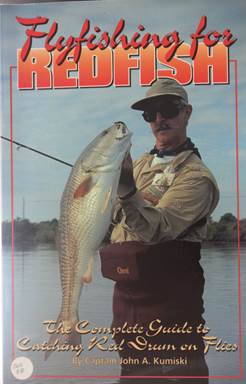
Now as for tackle; I prefer to use a nine foot rod for an eight weight line as to the type of rod, well I won't even go there, if you have a favorite brand than by all means have at it.
I will make two comments on rod, first always carry a spare rod if you only have one rod and you break and the fishing is good well then you are out of luck. My second comment on fly rod is that the fish really don't care about which brand you are using. Now 90% of the redfish that I catch are in shallow water therefore the two lines I use for reds are weight forward floating lines and type II sink tip lines along with adequate reels that will hold 100 to 150 yards of backing. Redfish don't make long hard runs but you can hook other species where you might need that extra backing. I use heavy hand tied tapered leaders that are designed to turn over the imitations and allows me to fight the redfish hard and fast. I will discuss my leader formula in another selection of the chronicles.
I have learned that the waters of the Indian River Lagoon are unique as it pertains to redfish because as they attain maturity and reach twenty pounds or so they generally move to coastal shoreline of the Atlantic Ocean and inlet passes. However the large redfish of the Indian River Lagoon remain in the shallower waters of the lagoon.
As a general rule redfish will move with the tides moving into the desirable shallow water feeding areas with the incoming tide bringing with it organisms which the redfish feed on to include crabs, shrimp and various minnows. When the tide moves out the redfish will slide out into the deeper edges of the channels. But remember in any local area there will be places that the fish feed better at low tides and other areas where the best fishing is on an incoming high tide and that is why local knowledge is so important.
Redfish in shallow clear water are very wary and are easily spooked by the clumsy angler therefore when you approach tailing redfish in a boat you should be carefully poling the boat and if you are wading you should approach slowly and carefully send out no bow wave and be very quite in the boat or wading as a dropped rod, clunky noise or a misstep by the wading angler can spook the fish. Therefore with tailing redfish you are trying to position yourself so you can drop your cast a couple of feet beyond the tailing fish and make your cast without lining the them.
If the redfish are cruising, once again the cast angle is critical and you need to be far enough ahead to fish so as not to spook them with the cast but in the cruising zone of the fish. Remember that each and every fishing situation is different and you must observe the situation and act accordingly. But there is one fact that is undeniable and that is if you want to try for redfish the Indian River Lagoon it is a good bet as they are plentiful. Redfish are opportunistic feeders and are seldom super picky, at least in my experience. I will tell you that Clouser minnows are effective on redfish however the Clouser is effective on a great many saltwater species. Now I will share a couple of my favorite redfish imitations that you may not be familiar with.
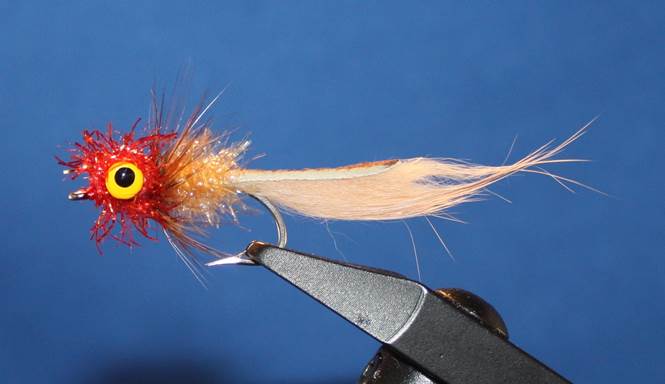
Anclote Key Red Headed Tan Shrimp
-Original pattern designed by Rod Walinchus
- Hook: Mustad 34007 Sizes: 1/0 to 6
- Thread: Red 6/0
- Tails: Tan Rabbit Strip, tied hair side down with two strands of Root Beer Krystal tied in side of the Rabbit Strip
- Body: Tan Crystal Chenille
- Collar: Brown Hackle
- Eyes: Dumb-bell type, painted yellow with black centers and coated with Sally Hansen's Hard As Nails for durability and tie the eyes on the top of the hook shank so the fly travels hook point up in the water.
- Head: Red Estaz
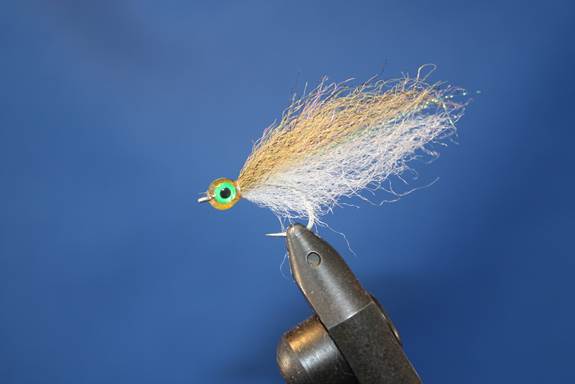
Backcountry Bullet Baitfish
- Hook: Mustad 34007 Sizes: 1/0 to 6
- Thread: Light Dun 6/0
- Wing/Body: White EP Fibers with six strands of Pearl Krystal Flash, topped off with EP Backcountry Fibers
- Head: Backcountry EP Fiber on top and White EP Fibers on the bottom, tied bullet style
- Eyes: 3D Green with Black centers, applied with epoxy where the entire head area and eyes are coated
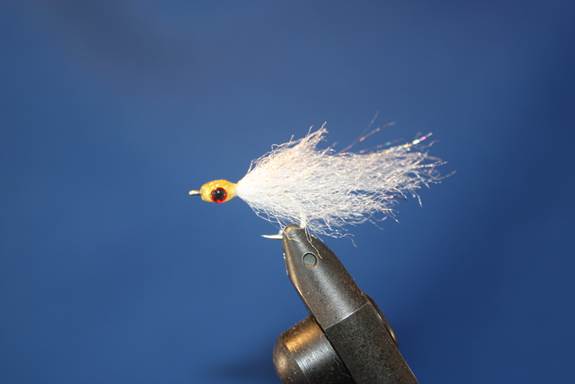
White Bullet Baitfish
- Hook: Mustad 34007 Sizes: 1/0 to 6
- Thread: White 6/0
- Wing/Body: White EP Fibers, with four strands of Silver Holographic Flash topped with more White EP Fibers
- Head: White EP Fibers top and bottom
- Eyes: 3D Red with Black centers, applied with epoxy where the entire head area and eyes are coated
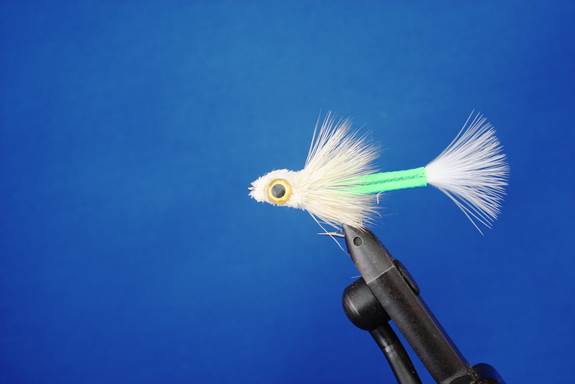
White & Chartreuse Pop-Ups Minnow
- Hook: Mustad 34007 or 3407 Sizes: 2/0 to 6
- Thread: A White or to match head Color
- Body & Tails: White Marabou pulled through a section of Chartreuse E-Z body material
- Collar: White Deer Hair, Flared
- Head: White Deer Hair, Flared, packed, stacked and trimmed to shape
- Eyes: 3-D Yellow with black centers, applied with epoxy
This pattern can be used with a Sink Tip as described in Pop-Ups published by Fly Angler's On Line as the second installment of the Saltwater Chronicles. This pattern is also effective when used on the surface with a floating line.

Simple Chartreuse & White Popper
- Hook: 34007 Mustad Sizes: 2/0-6
- Thread: White A
- Popper: Chartreuse Foam Popper, with 3D eyes Yellow with Black centers, applied with epoxy. There are many different popper styles that you can use. The choice is yours.
- Wing/Body: White EP Fibers with six strands of Silver Holographic Flash with Chartreuse EP Fibers on top. The Chartreuse EP Fibers are banded with a Black Sharpie marker
- Belly: White EP Fibers
There are many patterns that are effective; however these are the ones that I use.
Enjoy & Good Fishin'
| Sysadmin Note |
|---|
| Part 13 can be found here |
